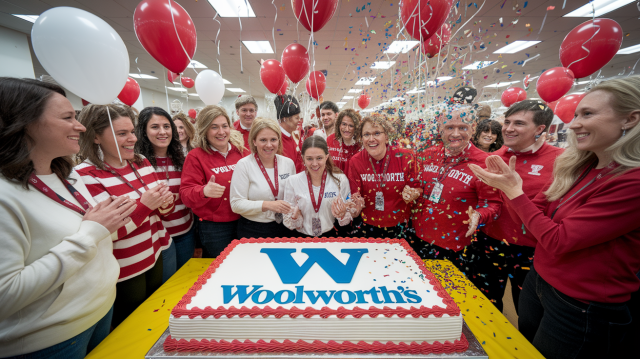Woolworth’s Day, celebrated annually on February 22, honors the legacy of Frank Winfield Woolworth and the revolutionary retail concept he introduced with his “Five and Dime” stores. On this day in 1879, Woolworth opened his first store in Utica, New York, pioneering the idea of selling goods at fixed prices of five and ten cents. Although the Utica store was short-lived, Woolworth’s perseverance led to the establishment of a successful retail chain that transformed shopping habits and created a lasting impact on consumer culture.
Why Is It Celebrated?
Woolworth’s Day is celebrated to recognize the innovative contributions of Frank W. Woolworth to the retail industry. His concept of fixed pricing and self-service shopping made goods more accessible to everyday people, laying the foundation for modern retail practices. The day also serves as a tribute to Woolworth’s resilience and entrepreneurial spirit, which turned a simple idea into a global phenomenon.
Cultural Significance
The “Five and Dime” stores became cultural icons in the late 19th and early 20th centuries, offering affordable goods and serving as community gathering spots. Woolworth’s Day celebrates this cultural heritage by highlighting how these stores shaped consumer habits, introduced fixed pricing, and made shopping more inclusive for people of all economic backgrounds.
Social Impact
Woolworth’s stores were more than just places to shop—they were integral parts of their communities. The iconic lunch counters became gathering places for social interaction and, later, sites of historical significance during the Civil Rights Movement. Woolworth’s Day also commemorates these contributions to social progress, particularly the role its lunch counters played in pivotal sit-ins advocating for racial equality.
The Importance of It
This day underscores the importance of innovation in business and perseverance in overcoming challenges. Woolworth’s legacy serves as an inspiration for entrepreneurs and a reminder of how one idea can revolutionize an industry. The day also highlights the role of retail in shaping societal norms and fostering community connections.
Educational Value
Woolworth’s Day provides an opportunity to learn about the history of retail innovation and its impact on society. Schools, museums, and community organizations often host events or discussions about Frank W. Woolworth’s life, his business model, and the broader historical context of his stores’ success.
Emotional Connection
For many people, Woolworth’s stores evoke nostalgia for simpler times when shopping was an enjoyable community experience. Woolworth’s Day fosters emotional connections by encouraging people to share memories of visiting these iconic stores or exploring their cultural significance.
The Origin of It
The first Woolworth store opened on February 22, 1879, in Utica, New York. Although it failed within weeks, Woolworth learned from his mistakes and opened a second store in Lancaster, Pennsylvania later that year, which became a success. The idea for Woolworth’s Day came from those who wanted to honor this pioneering business model and its lasting legacy.
Historical Events
- 1879: Frank W. Woolworth opens his first “Five Cent Store” in Utica, New York.
- 1880s-1900s: Woolworth expands his chain across the United States.
- 1913: The Woolworth Building opens in New York City as the tallest building in the world at that time.
- 1960: The Greensboro sit-ins at a Woolworth lunch counter become a pivotal moment in the Civil Rights Movement.
- 1997: The last U.S. Woolworth store closes as the company shifts focus to other ventures.
Evolution Over Time
Initially focused on celebrating retail innovation, Woolworth’s Day has grown to include reflections on its historical significance during the Civil Rights Movement and its influence on modern shopping habits. Events now often include discussions about entrepreneurship, social justice, and community-building.
How to Celebrate
- Visit Historical Sites: Explore locations tied to Woolworth’s legacy, such as preserved stores or museums commemorating its history.
- Host a 1950s-Themed Party: Celebrate with retro decor, classic music, and vintage-inspired snacks like milkshakes and burgers.
- Share Memories: Post stories or photos related to Woolworth’s stores on social media using hashtags like #WoolworthsDay.
- Learn About History: Read about Frank W. Woolworth’s life or watch documentaries about his impact on retail.
- Support Local Businesses: Honor Woolworth’s entrepreneurial spirit by shopping at small businesses or local markets.
- Reflect on Social Justice: Learn about the Greensboro sit-ins and other Civil Rights Movement milestones tied to Woolworth’s lunch counters.
Conclusion
Woolworth’s Day is more than just a celebration of a retail pioneer—it’s a tribute to innovation, resilience, and community impact. On February 22, 2025, let us honor Frank W. Woolworth’s contributions to modern retail while reflecting on how his stores became symbols of both progress and social change. Whether through sharing memories or learning about history, this day reminds us of how one visionary idea can leave an enduring legacy.












